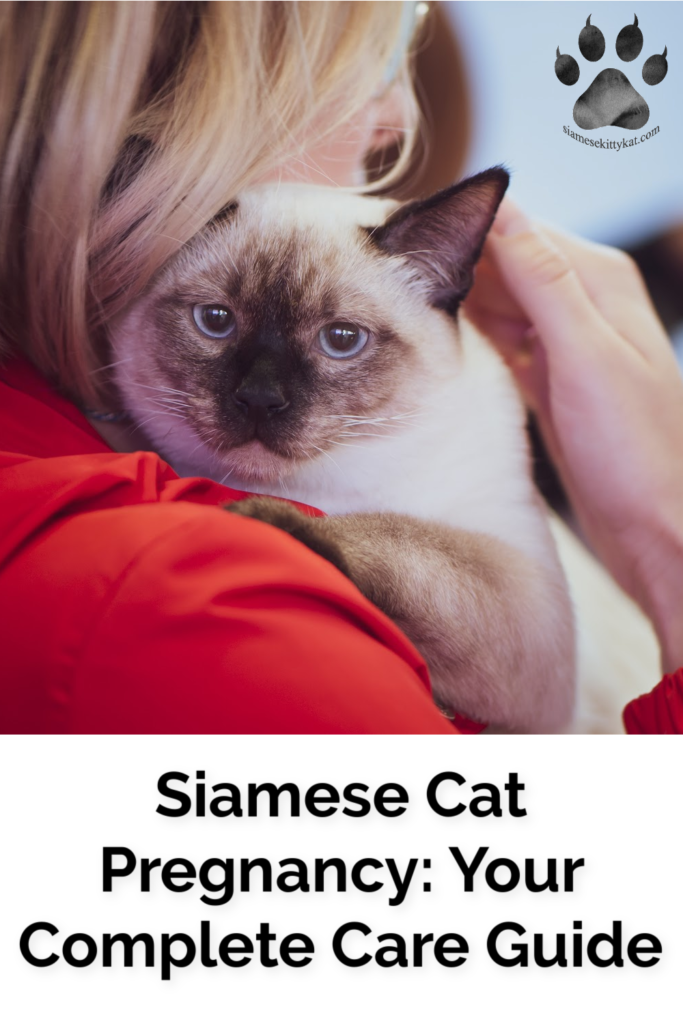So your Siamese cat is having kittens – how exciting! While new life in any form is a wonderful experience, it can also be full of questions and curiosities.
Since feline pregnancy is worlds away from what we’re used to as humans, it’s only natural to have some concerns.
For example, did you know that Siamese cats are only pregnant for 65 days on average, and they can have up to 9 kittens per litter?
Luckily for you, I’ve put together a complete care guide to help both you and your Siamese transition smoothly through this period. You’ll find everything from pre-pregnancy, a week-by-week guide, as well as aftercare.
Let’s make you the best grandparents you can be!
Is my cat in heat?
If your Siamese has yet to be spayed and is 6 – 10 months old, chances are you have experienced them in heat – or you’re soon going to.
Being “in heat” refers to a feline who is fertile and ready to mate. This happens many times during breeding season and not all year round.
Female Siamese cats get periods just like us humans, however, they are a little different. Instead of reaching for the nearest tub of ice cream and crying over cheesy sitcoms, a feline in heat will walk around, screaming at the top of their lungs (I know what you’re thinking, sounds like your typical Siamese, huh?) and spray urine around the house.
Female cats don’t get their period every month. They actually go into heat depending on how much sunlight is available. So in winter, a cat will go into heat far less than in summer.
A typical oestrus cycle will last around 4 – 5 days and will start up again 2 – 3 weeks later if they fail to become pregnant.
Felines will bleed ever so slightly, but unlike female dogs, it is often unnoticeable.
Signs your female Siamese is in heat
A cat in heat will always require extra attention and supervision. If they manage to get out of the house, there’s a high chance they can fall pregnant. Here’s a more in-depth guide to confirm whether your Siamese cat is in heat: Signs Your Siamese Cat is in Heat
Find effective techniques to calm a Siamese cat in heat through this step-by-step guide: Best Ways to Calm a Siamese Cat in Heat
If you’re not looking to become a grandparent, you should spay your Siamese as soon as possible. Spaying your Siamese will also stop her from developing certain health complications in the future.
How do I know if my cat is pregnant?

Aside from your Siamese gaining a considerable amount of weight during pregnancy, there are a few other tell-tale signs that you have a pregnant queen on your hands.
Physical Changes
Personality Changes
If you are unsure whether or not your Siamese is pregnant, a quick trip to the vet will be able to confirm or deny your theory.
If you’re sure you have a pregnant kitty on your hands, a trip to the vet isn’t necessary. However, it can be a good idea to confirm everything is going smoothly.
Here’s how they examine a pregnant cat:
How long are Siamese cats pregnant?

When it comes to feline pregnancy, there are 2 terms you will often hear:
Unlike us humans who experience 9 months of pregnancy, felines are only pregnant for 63 – 65 days!
Siamese cats, however, have a slightly longer pregnancy, usually lasting around 67 days.
Here are 4 interesting facts about the gestation period:
- A pregnant Siamese will be very hungry. On average, they consume around 2 – 4 times what they would usually.
- Kitten food is great for a pregnant cat. Kitten food is full of nutrients and high-protein that both mom and baby need. Consider feeding your pregnant cat kitten food right until the kittens have weaned off.
- The same litter can have different fathers. If your Siamese has mated with more than one cat within a close time frame, the same litter can have multiple fathers.
- You can terminate a cat’s pregnancy. Many vets will refuse to do so. But, if the pregnancy is life-threatening, it is possible to have it terminated.
A week-by-week run-through of a Siamese pregnancy
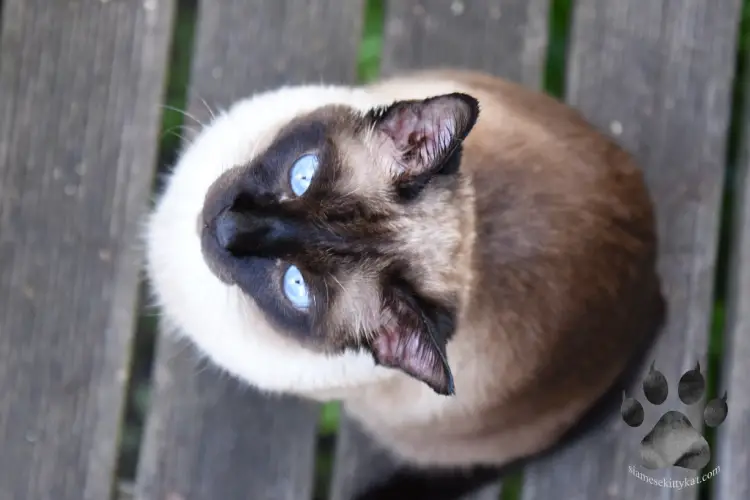
As I mentioned before, a feline pregnancy will typically last 9 weeks. Here is a week-by-week run-through of what to expect:
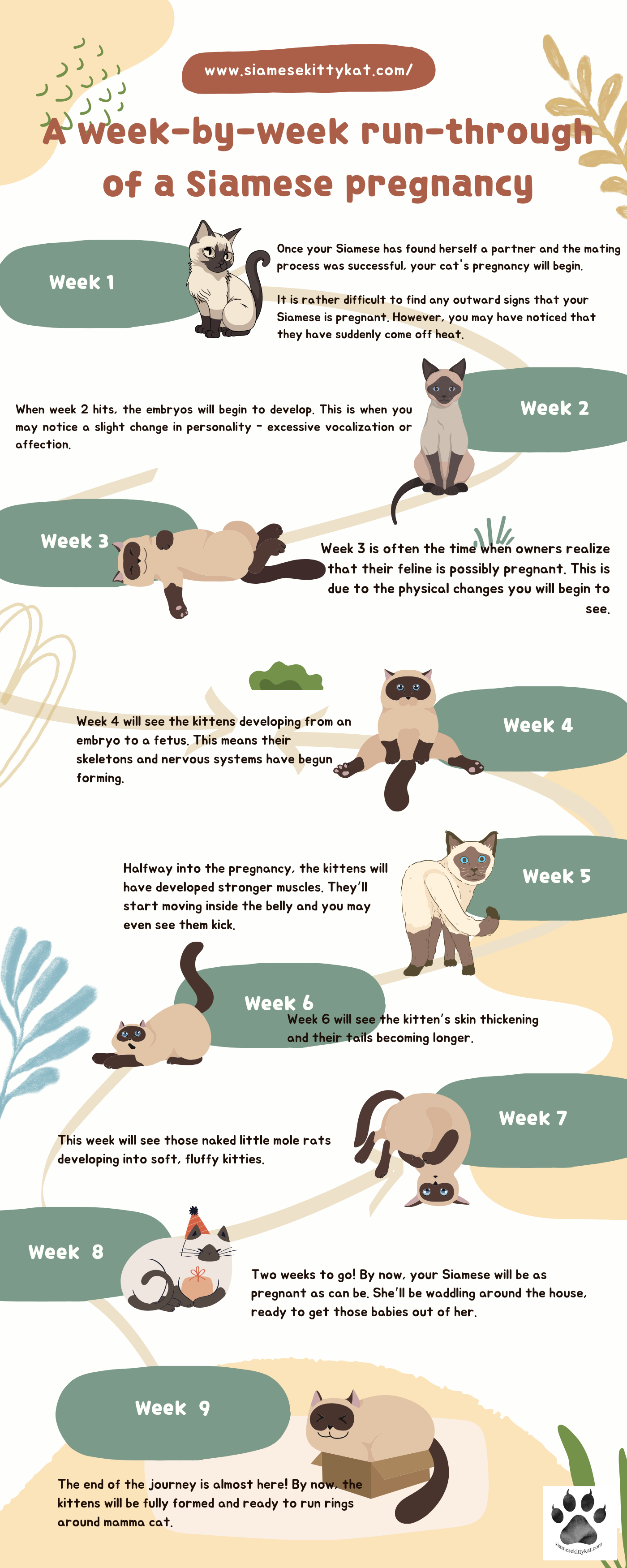
Week 1
Once your Siamese has found herself a partner and the mating process was successful, your cat’s pregnancy will begin.
It is rather difficult to find any outward signs that your Siamese is pregnant. However, you may have noticed that they have suddenly come off heat.
Week 2
When week 2 hits, the embryos will begin to develop. This is when you may notice a slight change in personality – excessive vocalization or affection.
If you’re unsure at this point whether your cat is pregnant, a trip to the vets will be able to confirm this for you.
Week 3
Week 3 is often the time when owners realize that their feline is possibly pregnant. This is due to the physical changes you will begin to see.
Their nipples will become larger and pinker. This is more noticeable in Siamese cats with lighter coats.
Week 3 is when the kittens begin forming legs, brains, internal organs, and circulatory systems. So it’s safe to say, this is an important week for them.
If you’re planning on taking your Siamese to the vet, now would be a great time. They can check whether or not your Siamese is healthy enough to undergo the pregnancy and fill you in on any dietary requirements.
Your Siamese can also have an ultrasound to confirm the pregnancy. However, it may not give you an accurate representation of how many kittens they are having.
Week 4
Week 4 will see the kittens developing from an embryo to a fetus. This means their skeletons and nervous systems have begun forming.
This is when your Siamese will begin to show outward signs of pregnancy such as morning sickness or a decrease in appetite. It isn’t guaranteed your cat will go through sickness however, it could be that they simply get bigger in size.
If your Siamese does experience morning sickness, it’s a good idea to make food available throughout the day. If your Siamese is vomiting more often than not and isn’t eating well, it is a good idea to contact your local vet.
Avoid picking up your Siamese from here on out. You may accidentally cause harm to her and her kittens.
Week 5
Halfway into the pregnancy, the kittens will have developed stronger muscles. They’ll start moving inside the belly and you may even see them kick.
This is also when you’ll begin to notice your Siamese’s abdomen getting bigger. If you’d like to know just how many grandchildren you are having, you can now take them for an x-ray.
Week 6
Week 6 will see the kitten’s skin thickening and their tails becoming longer.
In week 4 you may have noticed a decrease in appetite, but now it’s time to stock up on food! Her body will begin preparing for when the kittens arrive, therefore it will be begging for lots of nutrients and high-protein meals.
Make sure you feed your Siamese multiple meals per day. If you’re worried about her nutrient intake, you can always purchase special food for pregnant cats or mix in kitten food with her regular diet.
Week 7
This week will see those naked little mole rats developing into soft, fluffy kitties.
You will notice that your Siamese’s belly is unnoticeable – by now the whole neighborhood will know the news.
Mom to be will also be very thirsty, so ensure there is always fresh water on hand. You can try installing a cat fountain to encourage water intake.
Week 8
Two weeks to go! By now, your Siamese will be as pregnant as can be. She’ll be waddling around the house, ready to get those babies out of her.
It’s completely normal for her to lose fur around her nipples as it makes it easier for kittens to nurse. You may also notice a few milk droplets forming in preparation for the babies.
Your Siamese may have already found herself a nesting place. You’ll want to bring her food and water close so she doesn’t have to waddle far to get them.
Week 9
The end of the journey is almost here! By now, the kittens will be fully formed and ready to run rings around mamma cat.
Signs your cat is going into labour

When your cat goes into labor, it is only natural to want to help out as much as possible. However, it is always a good idea to leave her undisturbed.
You can watch from a distance to ensure everything is going well and no complications occur. However, you needn’t assist her throughout the entire process.
Signs labor is on the way include:
How to help a cat through labor
As I mentioned before, all you really need to do is give your Siamese a comfortable and safe environment. You can then sit back and watch the delivery process.
Giving birth is completely natural, so even if your Siamese is a first-time mom, their instincts will kick in. They are built to endure this, so unless any warning signs are given, she won’t need your help.
Here are the 3 stages of labor:
- The first stage of labor will last around 36 hours, shorter if she isn’t a first-time mom. You will notice your Siamese visiting her nesting spot often and is usually very restless. There may be a few noticeable contractions.
- During this stage, your Siamese will begin to give birth. This can be anywhere from 5 – 30 minutes per kitten. Mom will be able to chew through the cord herself and will need assistance.
- The last stage will involve passing the placenta for each kitten. She will most likely eat the placentas to hide that she gave birth.
Labor will typically last around 4 – 6 hours. If it goes on any longer than this, contact your vet for assistance.
How to ensure a healthy mom and kittens
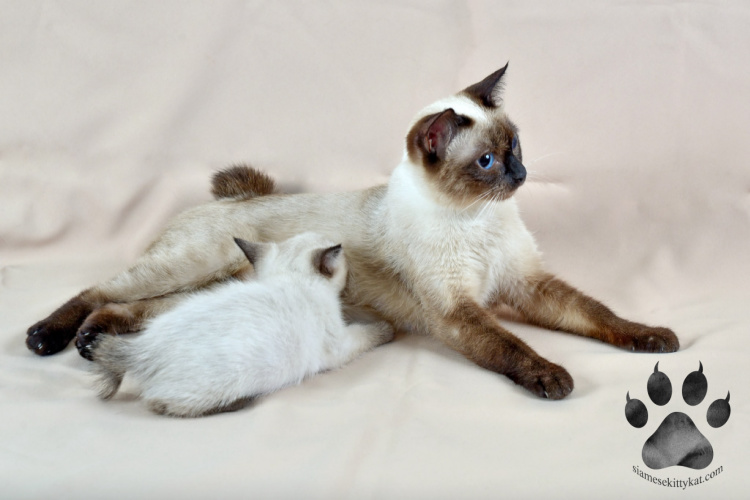
There are a number of ways you can help your Siamese stay happy and healthy through her pregnancy.
1. Petting
You will notice that your Siamese is even more affectionate than normal. This is due to an increase in hormones. During this time, she will crave lots of extra love and cuddles.
Reciprocating this love is a huge part of pregnancy. It will help them feel a lot more comfortable and safe within their environment.
That being said, you also have to take care when handling pregnant mamma. Stroking and petting are completely fine as long as you avoid the stomach.
One wrong move could cause her pain, as well as hurt her kittens. So, if you do need to pick your pregnant Siamese up, make sure to scoop her from her bottom.
Avoid any activities such as excess playing and jumping nearing the end of her pregnancy. You should keep her as calm as possible and keep the environment around her stress-free.
2. Vaccinations
Your Siamese should be up-to-date with her vaccinations prior to breeding. However, unexpected pregnancies can happen.
A healthy Siamese mother will pass her immunity to her kittens via her milk. So, it’s a good idea to visit your local vet to ensure she has all the right antibodies. Your vet can conduct a blood test to confirm this.
If your Siamese is due a vaccination, it’s important to remember that not all vaccinations are safe during pregnancy. Your vet will know which ones can and can’t be administered.
If your Siamese isn’t up-to-date with her vaccinations, you shouldn’t worry. Unless she is sick in other ways, the pregnancy should go smoothly and result in healthy kittens.
3. Parasites
Parasites such as worms can be passed from mom to kittens, so it is important to ensure your Siamese continues her worming treatment throughout her pregnancy. Flea treatments should also be kept up.
It’s a good idea to contact your local vet to ensure the treatment you are using is fine for both mom and babies.
Other things you should look out for include:
What complications can happen during feline pregnancy?
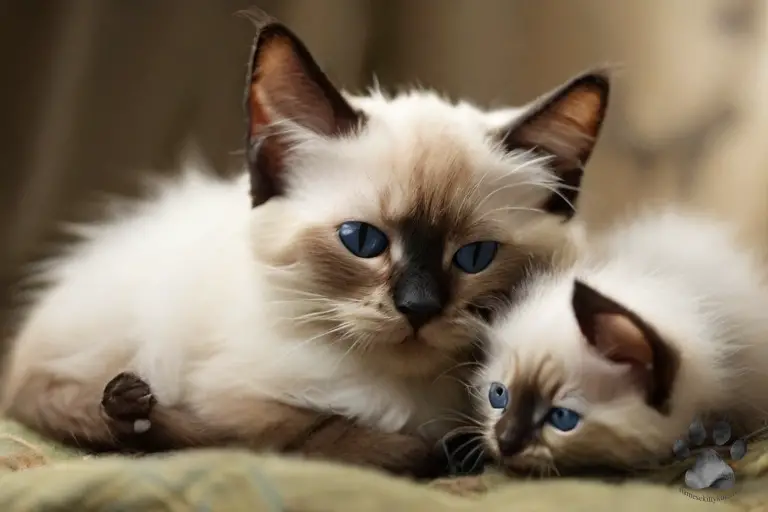
Unfortunately, there are a few complications that can happen during your Siamese cat’s pregnancy. Some can not be helped, and others should result in a trip to the vets immediately.
1. Miscarriage
If your Siamese has a miscarriage, don’t worry about her emotional distress. She won’t be upset by it and you may not even notice until later into her term.
If your Siamese has a miscarriage later into her pregnancy, it is a good idea to take a trip to the vets for a check-up. It is possible she will be at risk of infection.
2. Cesarean Section
Very rarely do cats have complications during labor, however, it does happen. In these cases, a cesarean section may be required.
This is more common in breeds who are known for having big heads and bodies such as Persians. It can also be required if your Siamese has previously experienced trauma to her pelvis.
If your Siamese has been in labor for over an hour without progress, you should immediately contact your vet for help.
3. Eclampsia
Eclampsia refers to a problem with low calcium during pregnancy. This is a lot more common in dogs, however, you should still look out for signs of twitching, agitation, or nervousness.
All of these signs could lead to a seizure if left untreated.
How can I make a nest for my pregnant cat?
During the two final weeks of pregnancy, you should encourage your cat to stay indoors. Even if your Siamese is an indoor cat, you should still create a nest where she can comfortably give birth and rest with her kittens.
When it comes to nest making, a cardboard box with some clean sheets or towels would be perfect. Or, you can also buy a ready-made cat nest like this super soft cat bed from Amazon.
When my childhood cat got pregnant a number of years ago, I found out the hard way that a tall box is essential if you don’t want the little critters escaping. One of the kittens went on an adventure and it took me 20 panicked minutes to locate her again!
Ensure the nest is in a quiet, comfortable environment and away from any drafts.
It’s also normal for your cat to find her own place to give birth. If this happens, feel free to move the kittens to the nest you created once they are born.
Your Siamese will not reject the kittens if you handle them after they are born.
She may also move the kittens to a different location after they are born, but if you believe the location isn’t safe or warm enough, feel free to relocate them.
I have used a microwave bean bag in the past and popped it under a blanket to keep the nest warm. Avoid using a water bottle as it may get popped with teeth and claws.
Feline pregnancy tips
Getting through feline pregnancy
Having a feline pregnancy can be equally nerve-wracking as it is exciting. If this is your first cat pregnancy, don’t worry too much!
It’s not often cats experience complications, and they will know what to do thanks to their instincts.
The most important thing is that you make your Siamese nice and comfortable throughout the entire thing, ensuring she has a safe place to give birth.
We gathered all the health tips tailored toward maintaining your Siamese cat’s optimal well-being. Check it out here: Siamese Cat Health: A Complete Guide
Get your FREE Siamese Cat 2024 Printable Calendar
